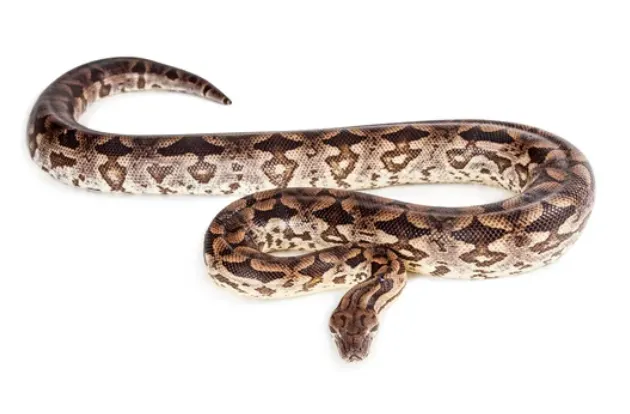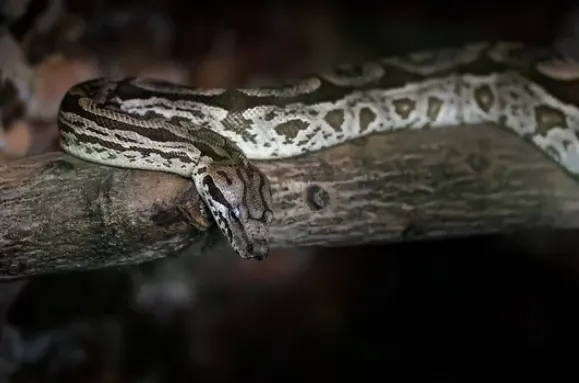Native to the lush forests of Madagascar, Dumeril’s boa (Acrantophis dumerili) is a fascinating, medium-sized snake known for its gentle nature and captivating patterns. This non-venomous boa has adapted well to human habitation, often living close to settlements and occasionally serving as an effective rodent control method. Despite its peaceful demeanor, this species has been misunderstood and feared by many, sometimes facing threats from humans who mistakenly consider it dangerous. Let’s dive into the captivating world of Dumeril’s boa and discover what makes this creature so unique.

A Glimpse Into the Dumeril’s Boa’s Natural Habitat
Dumeril’s boa is primarily found in the southern and southwestern regions of Madagascar, where it thrives in dry forest habitats. Unlike many snakes, Dumeril’s boa is mostly terrestrial, preferring the ground over trees. While juveniles may occasionally climb, adults spend their time hidden under leaves, in rocky crevices, or around human settlements where prey is abundant.
Due to its nocturnal lifestyle, this boa becomes most active at night, though cooler weather can draw it out during early mornings and evenings. Its ability to blend into its surroundings, thanks to its earth-toned colors, allows it to hide efficiently from both predators and prey.
Appearance: Nature’s Kaleidoscope
Dumeril’s boa is nothing short of a visual marvel. The snake’s body is decorated with intricate patterns of brown, grey, and chocolate hues that resemble a natural kaleidoscope. Its markings often mimic human face shapes, adding to its mystique. The boa’s elliptical pupils, characteristic of most boas, give it a distinct, almost cat-like appearance.
On average, Dumeril’s boas reach lengths between four and six feet, with some rare individuals growing up to seven feet. Females tend to be larger and heavier than males, making them more impressive in size. Despite their intimidating appearance, these boas are generally mild-mannered and non-aggressive.
Diet: The Role of the Boa in Madagascar’s Ecosystem
As a skilled ambush predator, Dumeril’s boa patiently waits for prey to approach. Its diet consists of a variety of small mammals, birds, and reptiles, with rats and juvenile lemurs being among its favorite meals. By controlling rodent populations, Dumeril’s boa plays a crucial role in maintaining balance within its ecosystem, contributing to the health of the forest environment.
Unfortunately, the boa’s habit of hunting domestic poultry has made it a target of humans. However, many people have come to appreciate the snake’s rodent-control abilities and choose to coexist peacefully with it.
Mating and Reproduction: A Unique Approach to Family Life
Dumeril’s boa exhibits a fascinating reproductive cycle. Mating takes place from March through May, with females typically giving birth to litters of 5-15 live young, known as neonates. Unlike many other snake species, Dumeril’s boas give live birth rather than laying eggs.
The neonates are born fully equipped to survive, measuring between 12 and 18 inches in length. From birth, they are independent and capable of hunting and fending for themselves. Maturity is reached at three to five years, at which point the cycle of life begins anew.
Threats and Conservation: A Species on the Rebound
In the past, Dumeril’s boa faced significant threats from over-collection for the pet trade, leading to concerns about its potential extinction. By 1991, the IUCN listed this species as vulnerable. However, the Convention on International Trade in Endangered Species (CITES) stepped in, placing the species on Appendix I, which prohibited its export. As a result, the population began to recover.
Today, the Dumeril’s boa is listed as Least Concern by the IUCN, a testament to its adaptability. The species has shown resilience in the face of habitat changes brought about by human development and continues to thrive near human settlements.
Behavior and Interaction With Humans
While Dumeril’s boas are mild-mannered and generally pose no threat to humans, they can be easily startled. When frightened, the snake may bite, though its bite is non-venomous and relatively harmless. The fear of these snakes is largely unfounded, as they prefer to be left alone and go about their business.
In some Malagasy tribes, Dumeril’s boas are even considered sacred. Folklore suggests that the snake’s skin holds the souls of ancestors, giving it a unique cultural significance. This belief has contributed to some areas treating the species with respect, though not everyone shares this reverence.
Fascinating Facts About Dumeril’s Boa
- “Do” in Malagasy: The native people of Madagascar call this snake “do,” pronounced like “dough.” It’s a term rooted in the Malagasy language and reflects the close relationship between the species and the local culture.
- Excellent Rodent Control: Dumeril’s boa helps keep rodent populations in check, which benefits farmers and reduces the need for chemical pest control methods.
- A Gentle Giant: Despite its size, this snake is often described as one of the more docile and easy-to-handle species, making it popular in the pet trade.

Identification: How to Spot a Dumeril’s Boa
Dumeril’s boas are often confused with other species of boas, but their unique appearance makes them stand out. Here’s a quick guide to identifying them:
- Base Color: Typically tan or greyish with dark brown or chocolate-colored patterns.
- Head Shape: A pointed nose with a broad jaw, giving the snake an aggressive look.
- Size: Adults typically range from 4 to 6 feet in length.
- Pupils: Elliptical, which is characteristic of many boa species.
While their camouflage allows them to blend seamlessly into their surroundings, these features can help you spot one if you’re lucky enough to see it in the wild.
A Snake Worth Knowing
Dumeril’s boa is a beautiful, misunderstood creature that plays an important role in Madagascar’s ecosystem. Despite its sometimes unwarranted reputation, this snake is far from dangerous to humans and can even be a beneficial neighbor, helping to control rodent populations.
Whether revered as sacred by some tribes or admired for its beauty and gentle nature, Dumeril’s boa deserves our respect and protection. Its story of survival, adaptability, and cultural significance in Madagascar is a reminder of the delicate balance between nature and human development.
- Enchi Ball Python: A Unique and Stunning Morph of Python regius - March 27, 2025
- Emerald Tree Monitor: The Enigmatic Green Guardian of the Rainforest - March 26, 2025
- The Egyptian Cobra (Naja haje): A Fascinating Serpent - March 25, 2025
